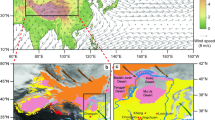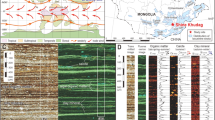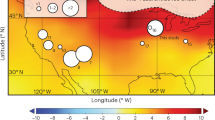Abstract
Abundant evidence from marine, ice-core and terrestrial records demonstrates that Earth’s climate has experienced co-evolution of orbital- and millennial-scale variability through the Pleistocene. The varying magnitude of millennial climate variability (MCV) was linked to orbitally paced glacial cycles over the past 800 kyr. Before this interval, global glaciations were less pronounced but more frequent, yet scarcity of a long-term integration of high-resolution continental and marine records hampers our understanding of the evolution and dynamics of MCV before the mid-Pleistocene transition. Here we present a synthesis of four centennial-resolved elemental time series, which we interpret as proxies for MCV, from North Atlantic, Iberian margin, Balkan Peninsula (Lake Ohrid) and Chinese Loess Plateau. The proxy records reveal that MCV was pervasive and persistent over the mid-latitude Northern Hemisphere during the past 1.5 Myr. Our results suggest that the magnitude of MCV is not only strongly modulated by glacial boundary conditions on Earth after the mid-Pleistocene transition, but also persistently influenced by variations in precession and obliquity through the Pleistocene. The combination of these four proxies into a new MCV stack offers a credible reference for further assessing the dynamical interactions between orbital and millennial climate variability.
This is a preview of subscription content, access via your institution
Access options
Access Nature and 54 other Nature Portfolio journals
Get Nature+, our best-value online-access subscription
$29.99 / 30 days
cancel any time
Subscribe to this journal
Receive 12 print issues and online access
$259.00 per year
only $21.58 per issue
Buy this article
- Purchase on Springer Link
- Instant access to full article PDF
Prices may be subject to local taxes which are calculated during checkout





Similar content being viewed by others
Data availability
The elemental data that support the findings of this research are provided in Extended Data files and in the East Asian Paleoenvironmental Science Database (https://doi.org/10.12262/IEECAS.EAPSD2021001). Source data are provided with this paper.
References
Overpeck, J. T. & Cole, J. E. Abrupt change in Earth’s climate system. Annu. Rev. Environ. Resour. 31, 1–31 (2006).
Denton, G. H. & Karlen, W. Holocene climatic variations—their pattern and possible cause. Quat. Res. 3, 155–205 (1973).
Dansgaard, W. et al. A new Greenland deep ice core. Science 218, 1273–1277 (1982).
Heinrich, H. Origin and consequences of cyclic ice rafting in the northeast Atlantic Ocean during the past 130,000 years. Quat. Res. 29, 142–152 (1988).
Bond, G. et al. Evidence for massive discharge of icebergs into the glacial North Atlantic. Nature 360, 245–249 (1992).
McManus, J. F., Anderson, R. F., Broecker, W. S., Fleisher, M. Q. & Higgins, S. M. Radiometrically determined fluxes in the sub-polar North Atlantic during the last 140,000 years. Earth Planet. Sci. Lett. 135, 29–43 (1998).
Bond, G. et al. Correlations between climate records from North Atlantic sediments and Greenland ice. Nature 365, 143–147 (1993).
Dansgaard, W. et al. Evidence for general instability of past climate from a 250 kyr ice-core record. Nature 364, 218–220 (1993).
McManus, J. F., Oppo, D. E. & Cullen, J. L. A 0.5-million-year record of millennial-scale climate variability in the North Atlantic. Science 283, 971–974 (1999).
Voelker, A. H. L. Global distribution of centennial-scale records for marine isotope stage (MIS) 3: A database. Quat. Sci. Rev. 21, 1185–1212 (2002).
Alley, R. B. et al. Abrupt climate change. Science 299, 2005–2010 (2003).
Hodell, D. A., Channell, J. E. T., Curtis, J. H., Romero, O. & Röhl, U. Onset of “Hudson Strait” Heinrich events in the eastern North Atlantic at the end of the middle Pleistocene transition (∼640 ka)? Paleoceanography 23, PA4218 (2008).
Cheng, H. et al. The Asian monsoon over the past 640,000 years and ice age terminations. Nature 534, 640–646 (2016).
Clemens, S. C. et al. Precession-band variance missing from East Asian monsoon runoff. Nat. Commun. 9, 3364 (2018).
Raymo, M. E., Ganley, K., Carter, S., Oppo, D. W. & McManus, J. F. Millennial-scale climate instability during the early Pleistocene epoch. Nature 392, 699–702 (1998).
Tzedakis, P. C., Hooghiemstra, H. & Palike, H. The last 1.35 million years at Tenaghi Philippon: revised chronostratigraphy and long-term vegetation trends. Quat. Sci. Rev. 25, 3416–3430 (2006).
Hodell, D. A. & Channell, J. E. T. Mode transitions in Northern Hemisphere glaciation: co-evolution of millennial and orbital variability in Quaternary climate. Clim. Past 12, 1805–1828 (2016).
Zhao, Y. et al. Evolution of vegetation and climate variability on the Tibetan Plateau over the past 1.74 million years. Sci. Adv. 6, eeay6193 (2020).
Channell, J. E. T. et al. A 750 kyr detrital-layer stratigraphy for the North Atlantic (IODP sites U1302–U1303, Orphan Knoll, Labrador Sea). Earth Planet. Sci. Lett. 317–318, 218–230 (2012).
Barker, S. et al. Icebergs not the trigger for North Atlantic cold events. Nature 520, 333–338 (2015).
Jouzel, J. et al. Orbital and millennial Antarctic climate variability over the past 800,000 years. Science 317, 793–796 (2007).
Thirumalai, K., Clemens, S. C., Partin, J. D. Methane, monsoons, and modulation of millennial-sclale climate. Geophys. Res. Lett. 47, e2020GL087613 (2020).
McIntyre, A. & Molfinot, B. Forcing of Atlantic equatorial and subpolar millennial cycles by precession. Science 274, 1867–1870 (1996).
Berger, A., Loutre, M. F. & Melice, J. L. Equatorial insolation: from precession harmonics to eccentricity frequencies. Clim. Past 2, 131–136 (2006).
Broecker, W. S., Bond, G. C., Klas, M., Clark, E. & McManus, J. F. Origin of the northern Atlantic’s Heinrich events. Clim. Dyn. 6, 265–273 (1992).
Ganopolski, A. & Rahmstorf, S. Rapid changes of glacial climate simulated in a coupled climate model. Nature 409, 153–158 (2001).
MacAyeal, D. R. Binge/purge oscillations of the Laurentide Ice Sheet as a cause of the North Atlantic’s Heinrich events. Paleoceanography 8, 775–784 (1993).
Zhang, X., Lohmann, G., Knorr, G. & Purcell, C. Abrupt glacial climate shifts controlled by ice sheet changes. Nature 512, 290–294 (2014).
Bassis, J. N., Petersen, S. V. & Mac Cathles, L. Heinrich events triggered by ocean forcing and modulated by isostatic adjustment. Nature 542, 332–334 (2017).
Hulbe, C. L., MacAyeal, D. R., Denton, G. H., Kleman, J. & Lowell, T. V. Catastrophic ice shelf breakup as the source of Heinrich event icebergs. Paleoceanography 19, PA1004 (2004).
Zhang, X., Knorr, G., Lohmann, G. & Barker, S. Abrupt North Atlantic circulation changes in response to gradual CO2 forcing in a glacial climate state. Nat. Geosci. 10, 518–523 (2017).
Hemming, S. Heinrich events: massive late Pleistocene detritus layers of the North Atlantic and their global climate imprint. Rev. Geophys. 42, RG1005 (2004).
Clement, A. C. & Peterson, L. C. Mechanisms of abrupt climate change of the last glacial period. Rev. Geophys. 46, RG4002 (2008).
Corrick, E. C. et al. Synchronous timing of abrupt climate changes during the last glacial period. Science 369, 963–969 (2020).
Clark, P. U. et al. The middle Pleistocene transition: characteristics, mechanisms, and implications for long-term changes in atmospheric \(p_{\mathrm{CO}_{2}}\). Quat. Sci. Rev. 25, 3150–3184 (2006).
Lisiecki, L. E. & Raymo, M. E. A Pliocene–Pleistocene stack of 57 globally distributed benthic δ18O records. Paleoceanography 20, PA1003 (2005).
Shackleton, N. J., Hall, M. A. & Vincent, E. Phase relationships between millennial-scale events 64,000–24,000 years ago. Paleoceanography 15, 565–569 (2000).
Martrat, B. et al. Four climate cycles of recurring deep and surface water destabilizations on the Iberian margin. Science 317, 502–507 (2007).
Hodell, D. A. et al. A reference time scale for Site U1385 (Shackleton Site) on the Iberian margin. Glob. Planet. Change 133, 49–64 (2015).
Wagner, B. et al. Mediterranean winter rainfall in phase with African monsoons during the past 1.36 million years. Nature 573, 256–260 (2019).
Vogel, H., Wagner, B., Zanchetta, G., Sulpizio, R. & Rosén, P. A paleoclimate record with tephrochronological age control for the last glacial–interglacial cycle from Lake Ohrid, Albania and Macedonia. J. Paleolimnol. 44, 295–310 (2010).
Liu, T. S. & Ding, Z. L. Chinese loess and the paleomonsoon. Annu. Rev. Earth Planet. Sci. 26, 111–145 (1998).
An, Z. S. The history and variability of the East Asian paleomonsoon climate. Quat. Sci. Rev. 19, 171–187 (2000).
Porter, S. C. & An, Z. S. Correlation between climate events in the North Atlantic and China during the last glaciation. Nature 375, 305–308 (1995).
Ding, Z. L., Ren, J. Z., Yang, S. L. & Liu, T. S. Climate instability during the penultimate glaciation: evidence from two high-resolution loess records, China. J. Geophys. Res. Atmos. 104, 20123–20132 (1999).
Sun, Y. B. et al. Influence of Atlantic meridional overturning circulation on the East Asian winter monsoon. Nat. Geosci. 5, 46–49 (2012).
Sun, Y. B. et al. High-resolution scanning XRF investigation of Chinese loess and its implications for millennial-scale monsoon variability. J. Quat. Sci. 31, 191–202 (2016).
Berger, A. Long-term variations of daily insolation and Quaternary climate change. J. Atmos. Sci. 35, 2362–2367 (1978).
Barker, S. et al. 800,000 years of abrupt climate variability. Science 334, 347–351 (2011).
Brook, E. J. & Buizert, C. Antarctic and global climate history viewed from ice cores. Nature 558, 200–208 (2018).
Zhang, X. et al. Direct astronomical influence on abrupt climate variability. Nat. Geosci. https://doi.org/10.1038/s41561-021-00846-6 (2021).
Naafs, B. D. A., Hefter, J. & Stein, R. Millennial-scale ice rafting events and Hudson Strait Heinrich(-like) events during the late Pliocene and Pleistocene: a review. Quat. Sci. Rev. 80, 1–28 (2013).
Voelker, A. H. L., de Abreu, L. in Abrupt Climate Change: Mechanisms, Patterns, and Impacts (eds Rashid, H. et al.) 15–37 (American Geophysical Union, 2011).
Schulz, M. & Mudelsee, M. REDFIT: estimating red-noise spectra directly from unevenly spaced paleoclimatic time series. Comput. Geosci. 28, 421–426 (2002).
Grinsted, A., Moore, J. C. & Jevrejeva, S. Application of the cross wavelet transform and wavelet coherence to geophysical time series. Nonlinear Process. Geophys. 11, 561–566 (2004).
Torrence, C. & Compo, G. P. A practical guide to wavelet analysis. Bull. Am. Meteorol. Soc. 79, 61–78 (1998).
Howell, P., Pisias, N., Ballance, J., Baughman, J. & Ochs, L. ARAND time-series analysis software (Brown Univ., 1997); https://github.com/jesstierney/arand
Acknowledgements
We thank X. K. Qiang and H. Zhao for conducting palaeomagnetic measurement, H. M. Fan, Y. Li, L. J. Liang, H. Wang, Y. Wang, Y. Yan, J. B. Zhao and M. Zhao for field and laboratory assistance and H. L. Zhao and C. Y. Rui for data analysis. The elemental data of IODP sites U1308 and U1385 were provided by the Integrated Ocean Drilling Program (IODP) (http://www1.ncdc.noaa.gov/pub/data/paleo). This work was supported by grants from the National Science Foundation of China (no. 41525008) and the Chinese Academy of Sciences (nos. XDB40000000 and 132B61KYSB20170005). The contribution of J.F.M. was supported in part by the US-NSF. X.Z. was supported by grant from the National Science Foundation of China (no. 42075047).
Author information
Authors and Affiliations
Contributions
Y.S. and Z.A. designed the study and initiated the loess drilling project. Y.S., J.F.M., S.C.C., X.Z., H.V., D.H. and Z.A. coordinated the interpretations of proxy data. F.G., T.W. and X.L. contributed to XRF scanning of loess samples and spectral analyses. D.H. contributed the XRF scanning data from the marine cores. All authors participated in discussion and interpretation of the data and provided comments and suggestions for the manuscript.
Corresponding author
Ethics declarations
Competing interests
The authors declare no competing interests.
Additional information
Peer review information Nature Geoscience thanks the anonymous reviewers for their contribution to the peer review of this work. Primary Handling Editor: James Super.
Publisher’s note Springer Nature remains neutral with regard to jurisdictional claims in published maps and institutional affiliations.
Extended data
Extended Data Fig. 1 Correlation of glacial/interglacial transitions and abrupt events in marine and continental records.
a, Chinese cave δ18O record13; (b) Si/Sr of IOPD Site U130812; (c) Ca/Ti of IODP Site U138539; (d) K counts of Lake Ohrid sediment40; and (e) Fe/K of Gulang loess. Blue dashed lines denote rapid glacial/interglacial transitions, and green dashed lines indicate abrupt climate events. Blue diamonds and green dots indicate the first-order and second-order time controls, respectively.
Extended Data Fig. 2 Age models of four centennial-resolved records.
First-order time controls (blue diamonds) denote glacial/interglacial transitions inferred from absolutely dated Chinese speleothem13 and globally stacked benthic δ18O records36. Second-order time controls (green dots) are derived from the timings of weak monsoon events in Chinese Speleothem13 and IRD events in IODP Site U130812. Paleomagnetic boundaries (red triangles) of these four records are also shown for comparison (B/M-Brunhes/Matuyama transition, TJ-Top Jaramillo, BT-Bottom Jaramillo, and CM-Cobb Mountain).
Extended Data Fig. 3 Spectral results of four elemental ratios and cave δ18O.
a, Spectral density of U1308 Si/Sr, U1385 Ca/Ti, and cave δ18O; (b) Spectral density of LO Ca/K, GL Fe/K, and cave δ18O. Grey bars denote millennial peaks above the 90% confidence level (red dashed lines).
Extended Data Fig. 4 Wavelet spectra of high-frequency components and standard deviations (s.d.) of four elemental ratios.
a, Power spectra of high-frequency components of U1308 Si/Sr, U1385 Ca/Ti, LO Ca/K, and GL Fe/K; (b) Power spectra of U1308 Si/Sr-s.d., U1385 Ca/Ti-s.d., LO Ca/K-s.d. and GL Fe/K-s.d. Black contours indicate the 5% significance level against red noise.
Extended Data Fig. 5 Cross-spectral comparison of the s.d. of four elemental ratios with LR04 stack and ETP.
Spectral results (brown) of the STDs of (a) U1308 Si/Sr-s.d. (b) U1385 Ca/Ti-s.d. (c) LO Ca/K-s.d. (d) GL Fe/K-s.d. and their coherency spectra vs. LR04 stack36 (blue) and ETP48 (pink). Spectral density is normalized and plotted on a log scale. Grey bars indicate dominant orbital peaks at the 100-, 41-, 23- and 19-kyr periods. Coherence spectra are plotted above 80% confidence level.
Extended Data Fig. 6 Correlation of abrupt climate events in MCV stack with cave δ18O record13 and synthetic Greenland temperature49.
Detection of abrupt climate events is based on their amplitude (>average deviation) and duration (>0.8 kyr) of high-frequency components of these three records. Light blue bars and pink numbers refer to interglacial marine isotope stages.
Source data
Source Data Fig. 2
Elemental data of U1308, U1385, Lake Ohrid and GL loess.
Source Data Fig. 3
High-frequency components and s.d. of four elemental proxies.
Source Data Fig. 5
MCV stack, speleothem δ180 and Greenland temperature.
Rights and permissions
About this article
Cite this article
Sun, Y., McManus, J.F., Clemens, S.C. et al. Persistent orbital influence on millennial climate variability through the Pleistocene. Nat. Geosci. 14, 812–818 (2021). https://doi.org/10.1038/s41561-021-00794-1
Received:
Accepted:
Published:
Issue Date:
DOI: https://doi.org/10.1038/s41561-021-00794-1
This article is cited by
-
Orbital- and millennial-scale Asian winter monsoon variability across the Pliocene–Pleistocene glacial intensification
Nature Communications (2024)
-
The structure and development of Loess Critical Zone and its soil carbon cycle
Carbon Neutrality (2024)
-
Iberian Margin surface ocean cooling led freshening during Marine Isotope Stage 6 abrupt cooling events
Nature Communications (2023)
-
Moist and warm conditions in Eurasia during the last glacial of the Middle Pleistocene Transition
Nature Communications (2023)
-
Astronomical forcing shaped the timing of early Pleistocene glacial cycles
Communications Earth & Environment (2023)



